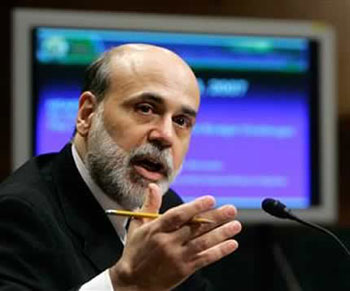 Chairman Bernanke has been praised for his handling of the crisis. Nobody disputes the fact that the massive emergency lending programs of the Federal Reserve helped to stabilize the financial system in the short-term; however, judging the first term of the Chairman purely on this ground is rather narrow minded.
Chairman Bernanke has been praised for his handling of the crisis. Nobody disputes the fact that the massive emergency lending programs of the Federal Reserve helped to stabilize the financial system in the short-term; however, judging the first term of the Chairman purely on this ground is rather narrow minded.
It is important to remember that the preamble of the Federal Reserve Act lays out a dual mandate for the Federal Reserve System: (1) provision of “an elastic currency” and (2) “effective supervision.” While the former provides short-term stability in the form of a lender of last resort (during crises) and of a reliable refinancing channel for banks (in normal times), the latter is intended to promote long-term stability. Unfortunately, supervision has always been seen as a secondary duty of the Federal Reserve System. The Fed, which is now overwhelmingly populated by economists (probably the least qualified to supervise banks), has too often ignored its dual mandate in favor of a single policy objective — managing price stability – which, importantly, was never the intended role of the Fed. Chairman Bernanke continues this tradition.
First, he (along with Governor Mishkin) is the main proponent of inflation targeting. Since 1999, he has been a strong advocate of purely focusing interest-rate settings on meeting an inflation target, while ignoring output growth and asset-price volatility. The models “showed” that price stability is the holy grail of policy goals that guarantees high (and stable) economic growth and financial stability. During his tenures as Governor and Chairman, this view has been at the core of his policy choices, and financial fragility has been largely left aside. Thus, from 2006, he continued Greenspan’s policy of raising policy rates to fight a presupposed looming “high” inflation, without any regard for an economy already extremely fragile. These policy actions contributed tremendously to systemic risk by pushing financial institutions and households into more leveraged positions (the worst mortgage originations occurred in 2005 and 2006, when the fed funds rate target was rising fast) and by creating large payment shocks on exotic mortgages. In addition, Chairman Bernanke did not consider the relevance of systemic risk until mid-2008, while many economists, journalists and bloggers from the financial community had been warning about the huge problems since 2005 at least.
Second, Chairman Bernanke has been a proponent of market-oriented regulation in the spirit of Basel II, and of the financial innovations that have been at the heart of the crisis. Mega financial institutions are supposed to know their business better and so, with some light oversight from the government, are supposed to be able to regulate themselves. Risk management, financial innovations and credit rating agencies are supposed to provide the proper signals and buffers against risks. This regulatory philosophy has failed miserably to prevent not only this crisis but also previous crises, and has contributed to growing financial instability over the past 30 years. In addition, the Federal Reserve has been unwilling to apply existing regulations to handle problematic banks and the Chairman has backed the shameless stress tests implemented under TARP. As Bill Black noted elsewhere, federal regulators are mandated to force recapitalization or to place in receivership insolvent institutions no matter how big they are. Receivership was done during the S&L crisis in a very smooth and competent way and it should be done today.
Third, the way the lender of last resort policy of the Federal Reserve has been implemented during the crisis has been flawed. The emergency lending programs have been highly opaque, creating suspicions of favoritism and unfair competitive practices. SIGTARP, US COP, and Bloomberg have been pushing hard for greater transparency (Bloomberg won a court battle but the Fed is now appealing). All those programs should have been done through the discount window, which should be destigmatized by making it the main way the fed intervenes on a daily basis.
Overall, Chairman Bernanke is not the right person to deal with the main concern that the Federal Reserve should, above all else, strive to maintain financial stability. Before the crisis, Chairman Bernanke ignored (or simply missed) the many warning signs until it was too late, and after the crisis he will likely return to his favored policy of targeting expected inflation.
One may wonder who the President should appoint as Fed Chairman. While I am not in the position to name anybody in particular, I can suggest some criteria. First, the Chairman should be a person who is old enough not to be concerned about finding a job once he or she leaves the Chairmanship. Second, she or he should be someone who is known for his or her independence of mind. Third, she or he should be someone that puts financial stability above all other criteria (because that is what the Fed was originally mandated to do and because it is the best way the Fed can promote price stability and stable economic growth). Finally, he or she should be someone who does not try to please the financial sector, and who involves much more other sectors of the economy in policy decisions.
- Bulenox: Get 45% to 91% OFF ... Use Discount Code: UNO
- Risk Our Money Not Yours | Get 50% to 90% OFF ... Use Discount Code: MMBVBKSM
Disclaimer: This page contains affiliate links. If you choose to make a purchase after clicking a link, we may receive a commission at no additional cost to you. Thank you for your support!



Leave a Reply